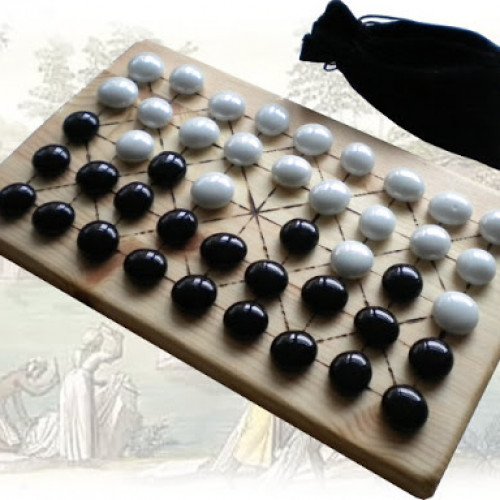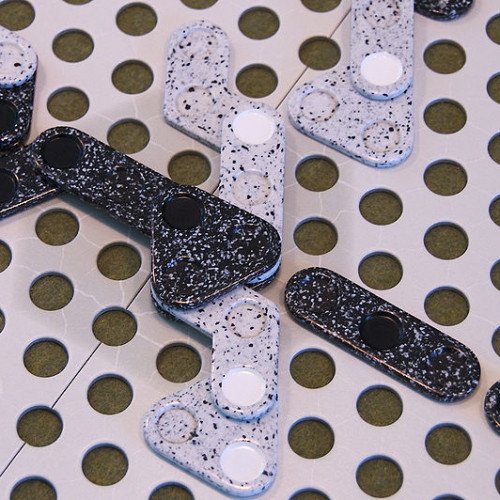FANORONA VS PÜNCT

FANORONA
Fanorona (Malagasy pronunciation: [fə̥ˈnurnə̥]) is a strategy board game for two players. The game is indigenous to Madagascar. Fanorona has three standard versions: Fanoron-Telo, Fanoron-Dimy, and Fanoron-Tsivy. The difference between these variants is the size of board played on. Fanoron-Telo is played on a 3×3 board and the difficulty of this game can be compared to the game of tic-tac-toe. Fanoron-Dimy is played on a 5×5 board and Fanoron-Tsivy is played on a 9×5 board—Tsivy being the most popular. The Tsivy board consists of lines and intersections that create a grid with 5 rows and 9 columns subdivided diagonally to form part of the tetrakis square tiling of the plane. A line represents the path along which a stone can move during the game. There are weak and strong intersections. At a weak intersection it is only possible to move a stone horizontally and vertically, while on a strong intersection it is also possible to move a stone diagonally. A stone can only move from one intersection to an adjacent intersection. Black and white pieces, twenty-two each, are arranged on all points but the center. The objective of the game is to capture all the opponents pieces. The game is a draw if neither player succeeds in this. Fanorona is very popular in Madagascar. According to one version of a popular legend, an astrologer had advised King Ralambo to choose his successor by selecting a time when his sons were away from the capital to feign sickness and urge their return; his kingdom would be given to the first son who returned home to him. When the king's messenger reached Ralambo's elder son Prince Andriantompokondrindra, he was playing fanorona and trying to win a telo noho dimy (3 against 5) situation, one that is infamously difficult to resolve. As a result, his younger brother Prince Andrianjaka was the first to arrive and inherited the throne.
Statistics for this Xoptio

PÜNCT
PÜNCT is a two-player strategy board game. It is the sixth (and final) release in the GIPF project of six abstract strategy games, although it is considered the fifth game in the project. It was released in 2005. PÜNCT won the Games Magazine Best Abstract Strategy game for 2007. The PÜNCT board game is one of six games a part of the GIPF project. This project was created by Kris Burm and is a series of six abstract games. PÜNCT is the 5th game of the project and the board of this game is shaped like a hexagon. This game was released in 2005.[citation needed] PÜNCT is a two-player connection game. The objective is to connect two sides of a hexagonal board, using pieces which cover three hexes each. The pieces can be placed, moved, rotated, and stacked in various ways, restricted by the geometry of the board, the shape of the pieces, and gravity. Players can bring new pieces to the board or can attempt to connect the pieces already in play. The objective of the game is to mislead the opponent. When the players take their first turn, they are not able to use the central hexagon. The PÜNCT piece is used as a point of reference throughout the game, but the PÜNCT piece can't be moved when the player is making a move. Minor dots can land on the other player's piece, but the PÜNCT piece may not. In order to make a move, three dots must be in perfect alignment. The pieces that are on top of all of the other pieces have the most power in this game. The dots on the ends of the pieces must be at the same level horizontally to play this game correctly. In order to make a bridge in this game, you must perform a jump move on a piece already on the board. The positions of the dots at the end don't have to be aligned with the middle or stable horizontally. When determining the winner, a player can lift one piece at a time to determine if a connection was made. To connect opposite sides in this game, players can move pieces on top of other pieces or they can stack pieces to block the opponent's connection, ergo, making a connection for themselves. The actual PÜNCT piece, which is a rounded piece that has one point, cannot be used to make a connection or form a “chain” but rather used as a point of reference.